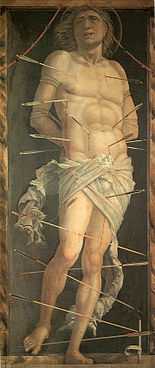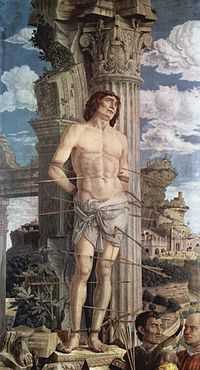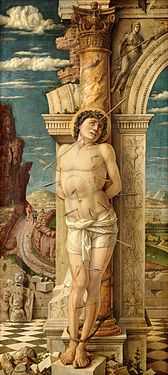St. Sebastian (Mantegna)
 |
| St. Sebastian |
| Andrea Mantegna, 1490 |
| Panel, 210 × 91 cm |
| Ca' d'Oro, Venice |
 |
| St. Sebastian |
| Andrea Mantegna, 1480 |
| Canvas, 255 x 140 cm |
| Musée du Louvre, Paris |
 |
| St. Sebastian |
| Andrea Mantegna, 1456–1459 |
| Panel, 68 × 30 cm |
| Kunsthistorisches Museum |
St. Sebastian is the subject of three paintings by the Italian Early Renaissance master Andrea Mantegna. The Paduan artist lived in a period of frequent plagues; Sebastian was considered protector against the plague as having been shot through by arrows, and it was thought that plague spread abroad through the air.
In his long stay in Mantua, furthermore, Mantegna resided near the San Sebastiano church dedicated to St. Sebastian.
The St. Sebastian of Vienna
It has been suggested that the picture was made after Mantegna had recovered from the plague in Padua (1456–1457). Probably commissioned by the city's podestà to celebrate the end of the pestilence, it was finished before the artist left the city for Mantua.
According to Battisti, the theme refers to the Book of Revelation. A rider is present in the clouds at the upper left corner. As specified in John's work, the cloud is white and the rider has a scythe, which he is using to cut the cloud. The rider has been interpreted as Saturn, the Roman-Greek god: in ancient times Saturn was identified with the Time that passed by and all left destroyed behind him.

Instead of the classical figure of Sebastian tied to a pole in the Rome's Campo Marzio ("Martial Field"), the painter portrayed the saint against an arch, whether a triumphal arch or the gate of the city. In 1457 the painter had been trialled for "artistical inadequacy" for having put only eight apostles in his fresco of the Assumption. As a reply, he therefore applied Alberti's Classicism principles in the following pictures, including this small St. Sebastian, though deformed by the nostalgic perspective of his own.

Characteristic of Mantegna is the clarity of the surface, the precision of an "archaeological" reproduction of the architectonical details, and the elegance of the martyr's posture.
The vertical inscription at the right side of the saint is the signature of Mantegna in Greek.
The St. Sebastian of the Louvre
The Louvre's St. Sebastian was once part of the Altar of San Zeno in Verona. In the late 17th century-early 18th century it was recorded in the Sainte Chapelle of Aigueperse, in the Auvergne region of France: its presence there is related to the marriage of Chiara Gonzaga, daughter of Federico I of Mantua, with Gilbert de Bourbon, Dauphin d'Auvergne (1486).
The picture presumably illustrates the theme of God's Athlete, inspired to a spurious sermon by St. Augustine. The saint, again tied to a classical arch, is observed from an unusual, low perspective, used by the artist to enhance the impression of solidity and dominance of his figure. The head and eyes turned toward Heaven confirm Sebastian's firmness in bearing the martyrdom. At his feet two iniquitous people (represented by a duo of archers) are shown: these are intended to create a contrast between the man of transcendent faith, and those who are only attracted by profane pleasures.
Apart from the symbolism, the picture is characterized by Mantegna's accuracy in the depictions of ancient ruins, as well as the detail in realistic particulars such as the fig tree next to the column and the description of Sebastian's body.
The St. Sebastian of Venice
The third St. Sebastian by Mantegna was painted some years later (c. 1490), and quite different from the previous compositions, shows a marked pessimism. The grandiose, tortured figure of the saint is depicted before a neutral, shallow background in brown colour. The artist's intentions for the work are explained by a banderol spiralling around an extinguished candle, in the lower right corner. Here, in Latin, it is written: Nihil nisi divinum stabile est. Caetera fumus ("Nothing is stable if not divine. The rest is smoke"). The inscription may have been necessary because the theme of life's fleetingness was not usually associated with pictures of Sebastian. The "M" letter formed by the crossing arrows over the saint's legs could stand for Morte ("Death") or Mantegna.
References
- Zuffi, Stefano (1991). Mantegna. Arnoldo Mondadori.
External links
- Louvre's St. Sebastian (Italian)